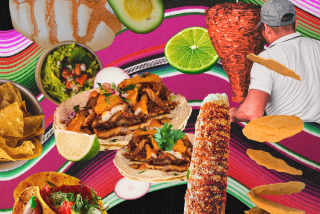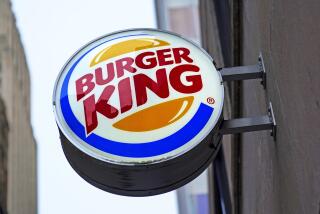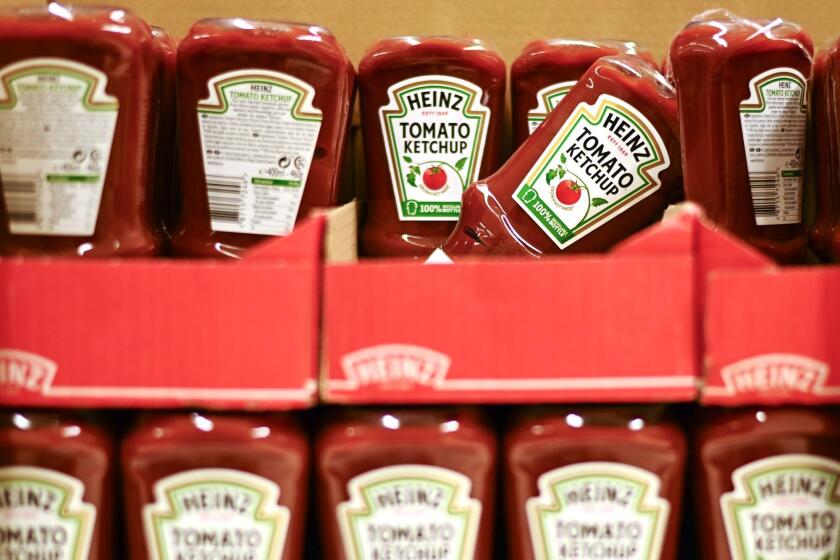Playing With Food : What You See Isn’t What You Get : Marketing: There are no formal guidelines for food styling. But there are cases where manufacturers went too far.
- Share via
Food styling, by its nature, is the art of deception: embellishing or beautifying the mundane. It creates great potential for misrepresentation of a product or particular dish. And the boundaries of what is legally acceptable are loosely drawn. There are no formal guidelines for the way food companies may showcase their products in advertisements, according to the Federal Trade Commission, which regulates advertising.
However, there was a landmark 1960s case that illustrates how far is too far.
The Campbell Soup Co. signed a consent agreement with the FTC agreeing to discontinue its practice of adding marbles to vegetable soup in the advertisement in order to make it appear that the broth was brimming with a bounty of produce. In reality, the soup was less hearty than pictured and the ad was thus considered “misleading,” according to Anne Maher, the FTC’s program adviser for food advertising.
In another case, ultimately heard by the U.S. Supreme Court, the FTC accused Colgate Palmolive of surreptitiously substituting one material for another, Maher said. Out of this decision came language applicable also to food ads.
“(The Supreme Court) said that if (an advertiser) substitutes mashed potatoes for ice cream and says, ‘Look at the ice cream’s thick and creamy texture,’ then that would be a case where a product was purporting to be something else entirely,” Maher said.
Although Maher said that deceptive food styling is an intriguing issue, the agency has not allocated many resources to the problem. Food advertising falls under the jurisdiction of the FTC’s Bureau of Consumer Protection, which has recently focused on the proliferation of exaggerated or misleading health claims regarding fat, sodium and cholesterol content in products.
“Health claims is an area where there is the most potential consumer injury,” Maher said. “It is a more important health and safety issue than the possibility that the consumer is not getting as aesthetically pleasing a food as (in the ad’s photo).”
An exception, Maher said, would be if the stylists made the food look more nutritious than it actually is. “If (appearances) were really important (to the advertisement) and then became an important part of the consumer’s purchasing decision then it might warrant (an agency) review,” she said. An example would be if an ad for a raisin bran breakfast cereal showed more raisins than actually existed in the product and then also stated that raisins provide important daily nutrition.
Advertisers are not the only ones who employ food stylists. Newspaper and magazines often feature photographs choreographed by stylists in elaborate test kitchens.
Barbara Fairchild, executive editor of Bon Appetit, said the magazine has definite guidelines for its food photos.
“No adulteration of the food for the benefit of photography is permitted,” Fairchild said. “We might make six versions of the same recipe to ensure that what we get is what we want, but we don’t help it out in any way that is false.”
Food photos done for magazines today are becoming more realistic, Fairchild said, something that is not always to the food’s benefit. There are limits to realism, however.
“People want to make food that looks attractive and we take that into consideration at the story proposal stage. If our staff wouldn’t serve the dish at their own dinner parties then why would our readers?” she asked.
Several major newspapers also have their own test kitchens and employ food stylists. Sharon Lane, food editor of the Seattle Times, said that her guideline is: all the food shown in the photo must be edible.
“We do not use shaving cremes for mashed potatoes . . . The (consumer) should see (in the photograph) what he or she can honestly create,” Lane said.
And although Times food stylists Minnie Bernardino and Donna Deane know the tricks of the trade, The Los Angeles Times policy on food styling is that the photographs are there to show readers what the dish will look like once it is cooked--not to seduce them into cooking it.
More to Read
Eat your way across L.A.
Get our weekly Tasting Notes newsletter for reviews, news and more.
You may occasionally receive promotional content from the Los Angeles Times.









